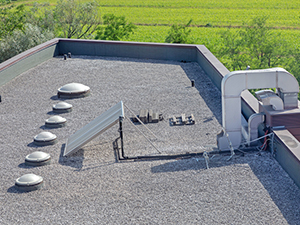
If you own or manage a commercial building in Battle Creek, MI, roofing longevity and durability should be at the top of your priorities. Among the most time-tested roofing systems available for flat or low-slope commercial buildings is Built Up Roofing (BUR). Known for its multiple layers of protection, this traditional roofing method offers excellent value for long-term performance.
To ensure your building remains protected against Michigan’s fluctuating weather, it is crucial to understand how BUR systems work and what makes them a reliable option. If you are considering installing or maintaining a built up roof, call JM Roofing Solutions at 269-361-8305 to discuss your options with a trusted local expert.
Top 5 Things Commercial Property Owners Should Know About BUR
When considering a BUR system for your commercial building in Battle Creek, understanding its benefits and challenges will help you make informed decisions. Here are the most important aspects to consider:
Proven Durability and Longevity
One of the biggest advantages of built up roofing is its long lifespan. When properly installed and maintained, a BUR system can last 20–30 years or more. The layered construction provides excellent resistance to water, UV rays, and mechanical damage, making it ideal for buildings that endure harsh weather or high foot traffic.
Excellent Waterproofing Abilities

BUR systems are inherently waterproof due to their multiple layers of bitumen. The redundancy in design ensures that even if the top layer is breached, the underlying layers continue to provide protection. This makes BUR especially effective in rainy or snowy climates like that of Battle Creek, MI.
Heavy Weight and Structural Considerations
While BUR systems offer great protection, they are significantly heavier than other flat roof options. This means your building must be structurally capable of supporting the added load. Before installation, a professional assessment is necessary to ensure compliance with local building codes and safety standards.
Maintenance and Inspection Requirements
Like any roofing system, BURs require regular maintenance to stay effective. Common tasks include checking for blisters or cracks in the surface, ensuring the gravel surfacing is evenly distributed, and cleaning debris that may hinder drainage.
Proper maintenance not only extends the life of the roof but can also help identify minor issues before they evolve into expensive repairs.
Cost vs. Value
Initial installation costs for BUR can be higher than other roofing systems due to the labor-intensive process and material needs. However, when weighed against its lifespan and low repair frequency, BUR offers an excellent return on investment. It is a smart long-term solution for commercial buildings that require strong, reliable roofing.
Built Up Roofing Professionals!
Michigan’s climate—with cold winters, snow accumulation, and occasional heavy rainfall—demands a roof that can stand up to varied challenges. BUR is well suited to meet those demands. If your commercial property has a flat or low-slope roof and structural support for heavier materials, BUR may be the right choice for you.
To determine if built up roofing is appropriate for your specific needs, consider speaking with local professionals who understand the region’s climate and building requirements. For tailored advice and expert service, call JM Roofing Solutions at 269-361-8305 today.
FAQ
How long does the built up roofing typically last?
When installed and maintained properly, BUR systems can last between 20 and 30 years, depending on the materials used and the climate.
Is built up roofing suitable for sloped roofs?
BUR is most effective on flat or low-slope roofs. For steep-slope applications, other roofing systems like metal or shingles may be more appropriate.
What kind of maintenance does a BUR system require?
Routine inspections for blisters, cracks, and gravel displacement are essential. Prompt repairs and periodic re-coating can also extend the roof’s lifespan.
How does BUR compare to modern single-ply systems?
While single-ply systems like TPO or EPDM are lighter and quicker to install, BUR offers superior durability through multiple protective layers. It often provides better long-term value, particularly for buildings that see frequent roof access or harsh weather.
Can a built up roof be repaired or must it be replaced entirely?
Minor damage to a BUR system can often be patched effectively. Full replacement is only necessary when the damage is extensive, or the roof reaches the end of its service life.
